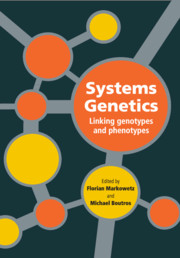
-
Select format
-
- Publisher:
- Cambridge University Press
- Publication date:
- July 2015
- July 2015
- ISBN:
- 9781139012751
- 9781107013841
- 9781108794596
- Dimensions:
- (247 x 174 mm)
- Weight & Pages:
- 0.72kg, 268 Pages
- Dimensions:
- (244 x 170 mm)
- Weight & Pages:
- 0.45kg, 272 Pages
You may already have access via personal or institutional login
Book description
Whereas genetic studies have traditionally focused on explaining heritance of single traits and their phenotypes, recent technological advances have made it possible to comprehensively dissect the genetic architecture of complex traits and quantify how genes interact to shape phenotypes. This exciting new area has been termed systems genetics and is born out of a synthesis of multiple fields, integrating a range of approaches and exploiting our increased ability to obtain quantitative and detailed measurements on a broad spectrum of phenotypes. Gathering the contributions of leading scientists, both computational and experimental, this book shows how experimental perturbations can help us to understand the link between genotype and phenotype. A snapshot of current research activity and state-of-the-art approaches to systems genetics are provided, including work from model organisms such as Saccharomyces cerevisiae and Drosophila melanogaster, as well as from human studies.
Reviews
'Since the completion of the Human Genome Project we hold the 'book of life' in our hands, but for the most part, we do not understand how to interpret it. We lack an understanding of the grammar that it is written in. With this book the authors put together an impressive collection of chapters that provide insights into our current efforts to understand how genetic information is integrated, coordinated and ultimately assembled into biological systems. If you are interested in how to decipher the grammar of life this is a must read!'
Frank Buchholz - Technische Universität Dresden, Germany
Contents
Metrics
Altmetric attention score
Full text views
Full text views help Loading metrics...
Loading metrics...
* Views captured on Cambridge Core between #date#. This data will be updated every 24 hours.
Usage data cannot currently be displayed.
Accessibility standard: Unknown
Why this information is here
This section outlines the accessibility features of this content - including support for screen readers, full keyboard navigation and high-contrast display options. This may not be relevant for you.
Accessibility Information
Accessibility compliance for the PDF of this book is currently unknown and may be updated in the future.


